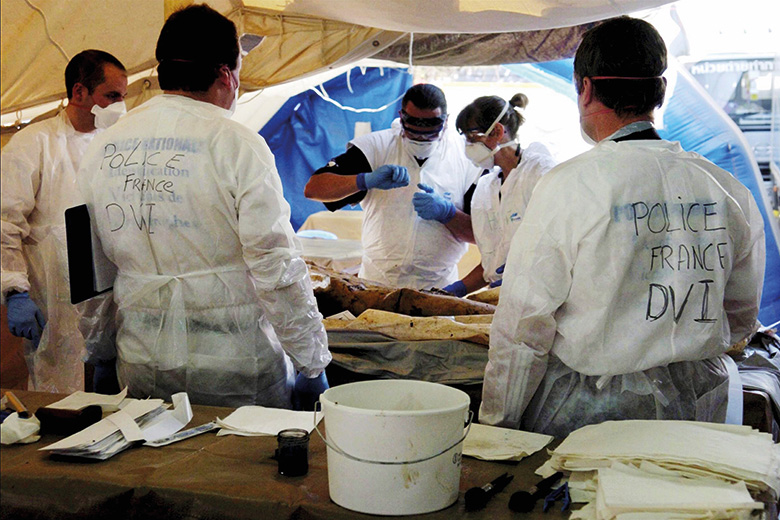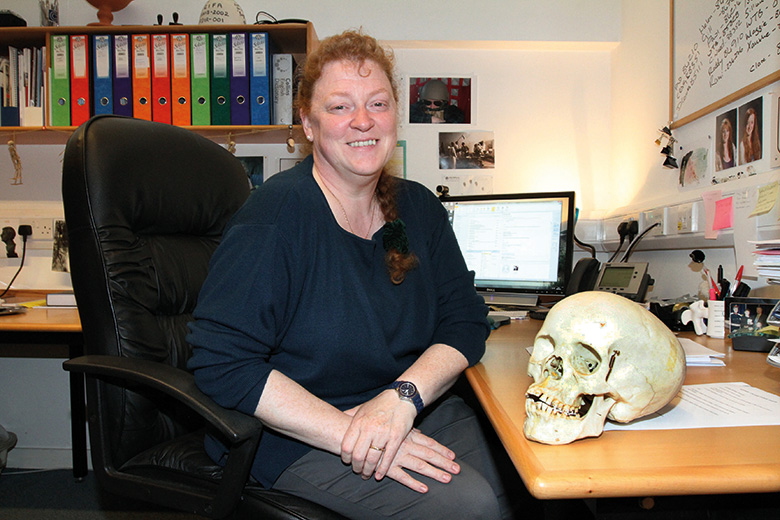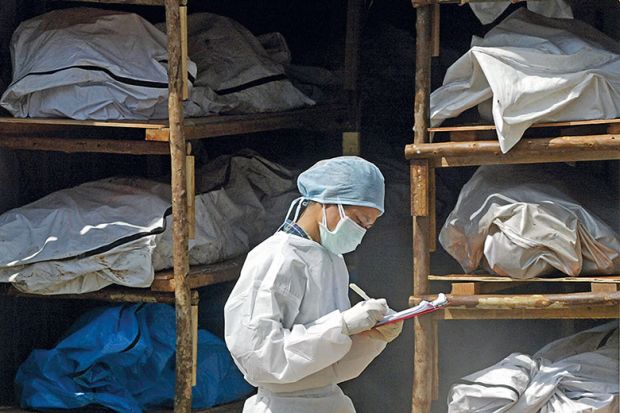"When you have a lot of people in one location and you have a lot of decomposition you get a little bit of mixing up of different parts of the body. So you would literally get down on your hands and knees and clear away every single piece of rubble until you come across something you think is human – whether it’s a foot or a hand or something else. [Then you say]: ‘Right, I’ve got a foot, where’s the leg? I’ve got the leg, where’s the pelvis?’”
Dame Sue Black is describing the career-defining work she did as a practising forensic anthropologist during the Kosovo War in 1999. It was the first chapter in a long career of helping to establish the grisly facts in a range of atrocities and disasters across the world: freelance casework that, she says, informs both her research and teaching at the University of Dundee, where she is professor of anatomy and forensic anthropology.
Black first became interested in anatomy when she got a job in a butcher’s shop at the age of 12, she tells Times Higher Education. She recalls her fascination with the “dissecting” of the animal carcasses that the job involved, and it was that experience, she says, that drove her decision to specialise in human anatomy as a student at the University of Aberdeen in the late 1970s.
“So I quickly transitioned from the butcher’s into human anatomy,” she says. “When I was doing my PhD [on ‘identification from the human skeleton’, also at Aberdeen], there was a forensic case and I thought: ‘OK. I can deal with muscle and blood. I can deal with dissection: can I deal with the human muscle and blood?’ ”
The answer was yes, and, by a process of “gentle desensitisation”, she became comfortable with decomposing bodies, too. “You get firsts of different examples [of cases], but it’s a gradual process. I wasn’t thrown into a mass fatality event,” she says.
After completing her studies in 1987, Black became an anatomy lecturer at St Thomas’ Hospital in London. In 1992, she returned to Scotland, working with the anatomy department at Aberdeen before taking up a role as a consultant forensic anthropologist for the University of Glasgow. Then, in 1999, she signed up with the UK’s Foreign and Commonwealth Office (FCO) to go out to Kosovo as lead forensic anthropologist in the UK forensic team assisting the International Criminal Tribunal for the former Yugoslavia (ICTY) as it investigated possible war crimes.
Her presence had been requested by Peter Vanezis, who was then Regius professor of forensic medicine and science at Glasgow. As the forensic pathologist who had initially travelled with the FCO to the region, Vanezis (who is now professor of forensic medical sciences at Queen Mary University of London) had observed the aftermath of an atrocity in which – according to the lone survivor – 44 Kosovan men had been herded into an outhouse by Serbian troops. The soldiers had then sprayed the outhouse with Kalashnikov gunfire and set it alight. What had confronted Vanezis, as the spring temperatures soared, was what Black describes as a mass of “commingled, very badly decomposed, partially burnt” bodies: a “writhing sea of maggots” which had also been “partly chewed” by roaming packs of wild dogs.
With forensic evidence needed to help build the legal case against Serbian leader Slobodan Milošević, bodies needed to be literally pieced together, and Vanezis realised that he needed Black’s help.
The deployment came in the early weeks of Nato’s intervention in the conflict between Serbian forces and the Kosovo Liberation Army, and “there were still…snipers in the hills [and] Serbian troops were still retreating. It was…incredibly challenging,” she recalls. “…[It was] one of those career-forming events: there was nothing else like it.”
Black was not fazed by the condition of the bodies: she was used to that. “What we certainly weren’t used to was the volume of them in such a small space,” she says. “There wasn’t really a tremendous amount of previous [field] experience you could draw down on; you were really learning what to do and how to do it as you hit the ground. Not in terms of the science and the subject, obviously, but how you apply that in a war zone.”
In Black’s seventh of eight tours to Kosovo, during the following year, she met a man whose entire family – including his eight children, his wife, his sister and his mother-in-law – had been wiped out by a rocket-propelled grenade. Despite having been shot himself, he had managed to crawl into the undergrowth, dig a hole and bury their “bloodied remains” so that the dogs would not get them.
“That takes some level of determination – when you think we found only half of his wife and the bottom half of his 12-year-old daughter,” Black says. Even for her, the recollection “sends shivers down your spine”.
The ICTY believed the area to be “an indictment site” because women and children had been targeted. Black had just finished writing a textbook on how to identify the remains of children, so was “probably one of the few people” in the UK able to “tell the difference between a 5-year-old and a 7-year-old” in such circumstances.
She notes that the team gave the man back 12 body bags: one for each lost family member and an extra one containing body parts “we could not separate out with confidence as belonging to any one individual”. “But there was unquestionably a part of every single one of the members of his family in each of those bags,” she adds.
Some in the British forensic team – particularly those from a police background – had questioned the necessity for someone with Black’s job description, assuming that anthropologists were always people who went “up the Amazon looking for tribes no one had ever come across”. However, Black’s work in Kosovo “cemented the need” for forensic anthropologists in victim identification when the bodies are badly damaged or decomposed.
“Academically, it was really one of the earliest [points at which] forensic anthropology was viewed as part of an international investigation capability,” she says. And the senior officers from London’s Metropolitan Police who administered the UK’s Kosovo team concluded that their force back home needed an anthropologist on every forensics team. “They’d realised that our ability to identify what was and was not human [and] to piece together a human [was vital],” Black says.

After Kosovo, further deployments took her as far afield as Grenada and Sierra Leone. In the latter country, racked by civil war, four United Nations peacekeeping soldiers had been shot just outside the capital, Freetown. There were question marks over whether this was a “natural outcome of conflict, or a war crime”, Black says, because of rumours that the hands of one of the soldiers had been tied. With the West African heat and humidity turning “a corpse to a skeleton inside seven days”, the forensics team had a small window in which to identify any wrongdoing. However, Sierra Leone was very much still an active conflict zone.
“The UN deployed four gunships to go up and down the edge of the jungle to discourage people from coming out and taking us hostage,” Black says. “The rebels would have really loved to have got a British hostage because the British forces were keeping them out of Freetown.” Along with genuine concerns about attracting gunfire, Black’s helicopter trip to the site was all the more “hair-raising” as the choppers the UN was using tended to “leave more nuts and bolts on the tarmac” than they took with them.
The fact that Black’s work revealed no war crimes might raise accusations that this intervention was a risk too far, but she insists that she only agrees to missions with which she is comfortable.
“I’m not gung-ho; if I thought it was too much of a risk I wouldn’t do it. There’s no benefit to a dead scientist: if they’re going to be of any value to anyone, they’ve got to live long enough to get their evidence out,” she says. “There are cases I’ve turned down because the risk was too high. It’s about personal security, but also responsibility to my own family.”
Her husband, whom she met when they were both 17, “knows” that she doesn’t put herself in harm’s way unduly, but she admits she did not feel able to tell her children much about her trips away when they were young.
In 2003, Black was appointed professor of anatomy and forensic anthropology at Dundee. But, in that same year, Western forces invaded Iraq, and Black was called on to undertake two tours to the desert country. Her expertise was useful most notably in the aftermath of one of the most notorious incidents of the war: the killing of British television journalist Terry Lloyd and his team by US forces after they were caught in the crossfire of a firefight with Iraqi forces.
Lloyd’s body was quickly discovered and repatriated, but his interpreter, Hussein Osman, and his cameraman, Frédéric Nérac, were still missing, presumed dead. Black was summoned after British forces found indications of where their bodies might have been buried.
“It was a very politically delicate situation,” Black says. “You literally do as you’re told. That was an experience: to be so curtailed in what we could do and couldn’t do: what we could say and what we couldn’t say.” But Black says her focus was on identifying bodies, not on passing judgement on what had happened: “We had no involvement whatsoever in the political…situation around that case.”
Black’s team succeeded in finding human remains that DNA analysis revealed “could well have been Osman’s”. Nérac’s body, though, was never found. The UK’s National Union of Journalists called Lloyd’s death a war crime, and an inquest later recorded a verdict of unlawful killing. However, insufficient evidence meant no charges were brought against any individual soldiers.
Less politically fraught but no less professionally demanding was Black’s experience as part of the British contribution to victim identification in Thailand following the 2004 Indian Ocean earthquake and tsunami.
Before her team could even begin identifying bodies, it was necessary to “get some semblance of order” to the “masses and masses” of them being found in the affected region. “People really didn’t know what to do with all the bodies they were finding,” Black says. “They would just go along the beach, pick up bodies and put them in the back of a truck [and] take them to the temples and leave them there. There was no indication of who had been found together, or which resort they’d come from. At various points there were in the region of 5,000 bodies requiring identification.”
The palpable difference between this and her previous experience in war zones was the lack of someone to blame: the sense of “futility” when faced with such a major, unpreventable natural disaster. For Black, one of the biggest challenges was coping with the fact that her team’s accommodation was in hotels where many of the victims had been staying. One reason for this, she says, was to “keep the economy going”, but she was surprised to find her lodgings no more comfortable than the military accommodation she was used to.

For all the unavoidable risk, Black is honest enough to admit that she is exhilarated by her work. “For me, this is the job I’ve trained to do. You get a huge adrenaline rush putting on your flak jacket and running to the back of a Chinook helicopter – it’s a huge adventure. You probably become a bit of an adrenaline junkie,” she says.
She clearly has the right temperament for dangerous situations. Casually, she drops into the conversation an anecdote about the time the helicopter she was travelling in during the Iraq war “literally falls” from the sky. “We think: ‘That’s it: we’ve been taken out by an RPG: we’re dead. I love my husband.’ Then, suddenly, we get covered in feathers and blood.”
The helicopter then righted itself. What had happened, it transpired, is that “a flock of birds had come out of nowhere, gone through the rotor, got sucked into the front of the helicopter and spat out the back – and we’d got covered in the carnage”.
Even being bitten by a potentially deadly snake in Kosovo was apparently more interesting than frightening to Black: “I got taken into a German military hospital and it was amazing to watch the venom slowly tracking up my venous system, seeing where it was going…I was naming the veins as they got more and more prominent. I was bored: they don’t give you a TV in a German military hospital!”
Black’s casework does not only take place overseas, however. Her involvement in domestic child sexual abuse cases, for instance, led to the conviction of members of Scotland’s largest paedophile ring in 2009. It also contributed to the 22 life sentences given in 2016 to Richard Huckle, one of the UK’s most prolific paedophiles, who admitted to 71 offences, with another 20 lying on file.
Although such casework is not academic research per se, Black says that it feeds into her research – which, in turn, informs her teaching. “They’re not separate worlds,” she says. “For example, the work we do on identification of perpetrators of child abuse: that came from a case [which highlighted that] we didn’t have the research on this. So, therefore, we go out, we get the funding to write the papers and do the research – and that means we can teach it in the classroom.”
Her casework often begins with the police coming to her and saying: “We’ve done everything we can on this: we can’t go further. Is there something you can do?” In the case of child abuse images, she notes that the photographs and videos frequently contain parts of the abuser’s own anatomy. “Often, it’s their hands, but it may be other parts if they interfere with the child. Our job is to use our experience of anatomy and the variation of anatomy to be able to say to the police: ‘It physically [can or] can’t be the man you suspect.’”
It seems remarkable that Black can speak so matter-of-factly about experiences that might be expected to disturb even the hardiest of souls. But she insists that dispassion is all part of the job.
“However much we may desperately want to help somebody, the truth is that we’re there to assist the law,” she says. “Our job is to recover the evidence, to analyse the evidence and to report on it. It’s a very clinical detachment…It doesn’t make me cold, clinical or uncaring, I don’t think. It makes me pragmatic – which is what scientists should be.”
Register to continue
Why register?
- Registration is free and only takes a moment
- Once registered, you can read 3 articles a month
- Sign up for our newsletter
Subscribe
Or subscribe for unlimited access to:
- Unlimited access to news, views, insights & reviews
- Digital editions
- Digital access to THE’s university and college rankings analysis
Already registered or a current subscriber? Login




